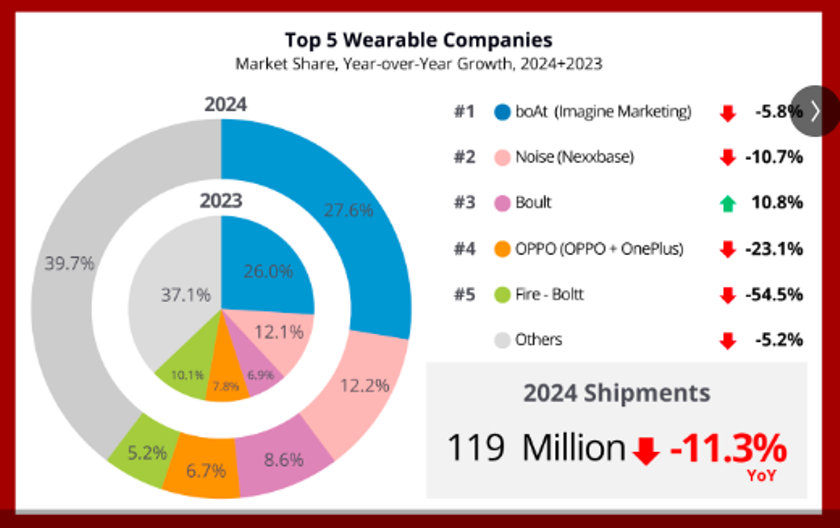India’s wearable device shipments declined in 2024, for the first time ever, falling 11.3 percent to 119.0 million units, according to International Data Corporation.

The wearable device market shrunk for the third consecutive quarter, down 8.7 percent to 25.9 million units in 4Q24.
The average selling price (ASP) for overall wearables declined by 7.1 percent to $19.8 in 2024, after five years of double-digit decline.
Smartwatch market in India
The smartwatch market in India declined 34.4 percent in 2024.
Noise (Nexxbase) led the market with a 25.2 percent share, despite a drop of 25.2 percent. Fire-Boltt, which held the largest share in CY23, saw a decline to 16.7 percent, losing 54.8 percent of its market presence.
boAt also faced a sharp drop of 44.7 percent, bringing its share down to 11.8 percent. Titan and Boult witnessed relatively smaller declines, with Titan reaching a 9.4 percent share and Boult at 4.9 percent. The “Others” category, encompassing smaller brands, collectively gained market share, growing from 31.1 percent to 32.0 percent, though still experiencing an overall volume decline of 32.7 percent.
The smartwatch market’s performance in Q4CY24 was even more severe, with an overall decline of 49.0 percent compared to Q4CY23. Noise maintained its leading position with 24.8 percent market share, though it suffered a 33.3 percent decline from Q4CY23.
Fire-Boltt’s market share dropped drastically from 22.2 percent to 10.6 percent, reflecting a 75.6 percent decline. boAt also saw a steep drop of 39.4 percent, settling at an 11.6 percent share. Titan and Boult faced contractions of 36.0 percent and 36.1 percent, respectively, while the “Others” category held 36.1 percent of the market, but with a 50.2 percent decline in volume.
True Wireless Stereo (TWS) market
The True Wireless Stereo (TWS) market in India grew by 9.4 percent in CY24 compared to CY23, with boAt maintaining its dominant position at 34.2 percent market share, reflecting a 10.4 percent year-over-year growth. Boult strengthened its presence, growing by 32.8 percent to capture 13.0 percent of the market. Noise also expanded its share to 8.9 percent, registering an impressive 24.0 percent growth. OPPO (including OnePlus) saw a decline of 7.7 percent, bringing its market share down to 6.0 percent. Realme posted the highest growth rate of 66.9 percent, though its market share remained modest at 5.8 percent. The “Others” category, which includes smaller brands, experienced a slight decline of 4.0 percent, reducing its share to 32.1 percent.
In Q4CY24, the True Wireless Stereo market surged by 21.7 percent compared to Q4CY23. boAt led the segment with a 30.5 percent share, growing 38.9 percent from the previous year’s quarter. Boult followed closely with a 33.5 percent increase, reaching 13.0 percent share. Noise’s market share dipped slightly to 8.8 percent, marking a 1.1 percent decline. OPPO witnessed a significant 91.7 percent growth, increasing its Q4 market share to 6.7 percent. Realme also experienced solid growth of 10.3 percent, securing 3.2 percent share. The “Others” segment remained the largest category, holding 37.8 percent of the market with a 7.5 percent increase in Q4 sales.
Indian smart wearable market
The Indian smart wearable market declined by 11.3 percent in CY24 compared to CY23, with total shipments dropping from 134.2 million to 119.0 million units. The smartwatch category saw the steepest decline, falling by 34.4 percent to 35.0 million units, making it the worst-performing segment. Wristbands also declined by 17.9 percent, with shipments reducing to 169.4 thousand units. Earwear, the largest category, grew marginally by 3.8 percent to 83.5 million units, while smart rings emerged as the fastest-growing segment with an impressive 186.8 percent surge, reaching 322.9 thousand units. Smart glasses remained niche, witnessing a decline of 13.7 percent with just 13.6 thousand units shipped.
In Q4CY24, the market contracted by 8.7 percent compared to Q4CY23, with total shipments decreasing from 28.4 million to 25.9 million units. Smartwatches experienced a sharp 49.0 percent decline, dropping from 13.3 million to 6.8 million units. In contrast, earwear grew by 26.8 percent to 19.0 million units, reflecting strong demand. Smart rings continued their rapid rise with a 62.5 percent increase in shipments, reaching 93.6 thousand units. Wristbands showed a modest recovery with a 7.6 percent growth in Q4, while smart glasses saw a significant drop of 55.4 percent, reinforcing their limited market presence.
Baburajan Kizhakedath
